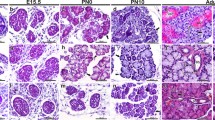Abstract
Crooke's cells are nonneoplastic corticotroph cells found in the adenohypophysis of patients who have an endogenous or exogenous excess of glucocorticoids. Classic Crooke's cells have a prominent hyaline cytoplasmic ring that displaces the basophilic granules of the normal cell. This characteristic appearance is produced by a perinuclear accumulation of cytokeratin filaments. Immunohistochemistry for cytokeratins is a sensitive way to identify Crooke's cells, but a keratin antibody specific for Crooke's hyaline change has not been reported. Normal pituitary epithelial cells are variably reactive for many keratin antibodies but are negative for cytokeratin 20 (CK20) expression. We evaluated the use of CK20 immunohistochemistry as a marker for Crooke's cells. We examined sections from 25 pituitary glands resected from 15 patients who had undergone exogenous glucocorticoid administration and from 10 patients with an endogenous source of hypercortisolism; sections from 10 normal pituitary glands obtained at autopsy were used as controls. CK20 immunoreactivity was observed only in corticotrophs. A staining pattern consistent with classic Crooke's cells was seen in pituitary gland sections from 15 of the cases. Cells with less intense CK20 positivity were present in sections from all 25 cases. We found CK20 to be a sensitive and specific marker for Crooke's cells and also for the previously unrecognized, subtle, cytoskeletal changes that occur in corticotrophs in response to hypercortisolism.
Similar content being viewed by others
References
Crooke AC. A change in the basophil cells of the pituitary gland common to conditions which exhibit the syndrome attributed to basophil adenoma. J Path Bacteriol 41:339–349, 1935
Laqueur GL. Cytological changes in human hypophyses after cortisone and ACTH treatment. Science 112:429–430, 1950.
Ogawa A, Sugihara S, Nakanishi Y, et al. Intermediate filament expression in non-neoplastic pituitary cells. Virchows Arch B Cell Pathol Incl Mol Pathol 58:331–340, 1990.
Halliday WC, Asa SL, Kovacs K, Scheithauer BW. Intermediate filaments in the human pituitary gland: an immunohistochemical study. Canad J Neurol Sci 17:131–136, 1990.
Uei Y. Immunohistological study of Crooke's cells, Pathol Res Pract 183: 636–637, 1988.
Neumann, PE, Horoupian DS, Goldman JE, Hess MA. Cytoplasmic filaments of Crooke's hyaline change belong to the cytokeratin class. An immunocytochemical and ultrastructural study. Am J Pathol 116:214–222, 1984.
Uei Y, Kanzaki M, Yabana T. Further immunohistochemical study of Crooke's hyalin. Pathol Res Pract 187:539–540, 1991.
Kasper M, Kasper M, Kern F, Heitz PU, Gudat F. Immunohistochemical studies on human pituitary gland and adenomas. J Hirnforsch 32: 725–734, 1991.
Kasper M, Stosiek P, van Muijen GN, Moll R. Cell type heterogeneity of intermediate filament expression in epithelia of the human pituitary gland. Histochemistry 93:93–103. 1989.
Moll R, Lowe A, Laufer J, Franke WW. Cytokeratin 20 in human carcinomas. A new histodiagnostic marker detected by monoclonal antibodies. Am J Pathol 140:427–447, 1992.
Wildi S, Kleeff J, Maruyama H, et al. Characterization of cyrokeratin 20 expression in pancreatic and colorectal cancer. Clin Cancer Res 5:2840–2847, 1999.
Miettinen M. Keratin 20 immunohistochemical marker for gastrointestinal, urothelial, and Merkel cell carcinomas. Mod Pathol 8: 384–388, 1995.
Coons SW, Estrada SI, Gamez R, White WL. Cytokeratin CK 7 and CK 20 expression in pituitary adenomas. Endocr Pathol 16:201–210, 2005.
George DH, Scheithauer BW, Kovacs K, et al. Crooke's cell adenoma of the pituitary: an aggressive variant of corticotroph adenoma. Am J Surg Pathol 27:1330–1336, 2003.
Dabbs DD. Diagnostic immunochemistry. In: Cerilli LA, Wick MR, eds. Immunohistology of soft tissue and osseous neoplasms. Philadelphia: Churchill Livingstone, 2002; 59–60.
Asa SL. Atlas of tumor pathology, tumors of the pituitary gland. Washington, DC: Armed Forces Institute of Pathology, 1998.
Kovacs K, Horvath E, Stratmann IE, Ezrin C. Cytoplasmic microfilaments in the anterior lobe of the human pituitary gland. Acta Anat (Basel) 87:414–426, 1974.
DeCicco FA, Dekker A, Yunis EJ. Fine structure of Crooke's hyaline change in the human pituitary gland. Arch Pathol 94:65–70, 1972.
Wagermark J, Wersall J Ultrastructural features of Crooke's changes in pituitary basophil cells. Acta Pathol Microbiol Scand 72:367–375, 1968.
Flitsch J, Ludecke DK, Knappe UJ, Saeger W. Correlates of long-term hypocortisolism after transsphenoidal microsurgery for Cushing's disease. Exp Clin Endocrinol Diabetes 107:183–189, 1999.
Saeger W, Geisler F, Ludecke DK. Pituitary pathology in Cushing's disease. Pathol Res Pract 183:592–595, 1988.
Author information
Authors and Affiliations
Corresponding author
Rights and permissions
About this article
Cite this article
Eschbacher, J.M., Coons, S.W. Cytokeratin CK20 is a sensitive marker for Crooke's cells and the early cytoskeletal changes associated with hypercortisolism within pituitary corticotrophs. Endocr Pathol 17, 365–376 (2006). https://doi.org/10.1007/s12022-006-0008-y
Issue Date:
DOI: https://doi.org/10.1007/s12022-006-0008-y




